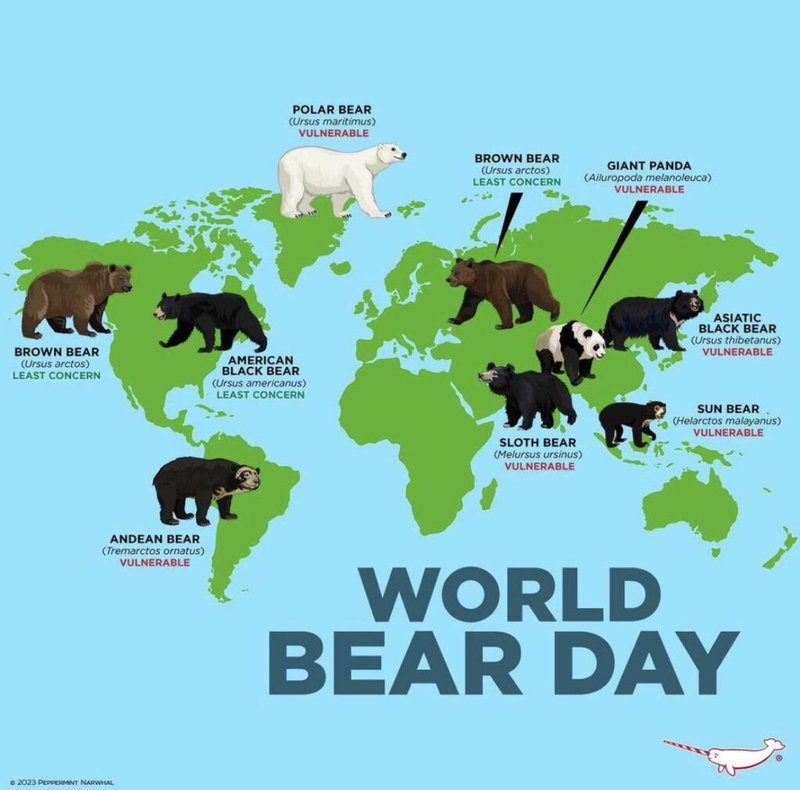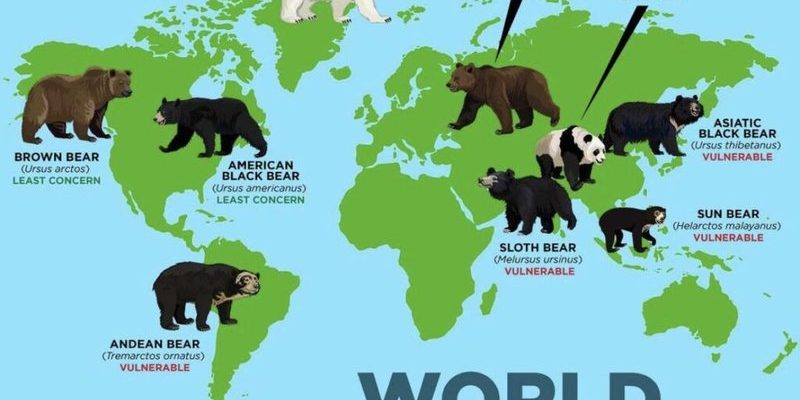
Just like we humans love cozy homes, bears have specific preferences for where they roam. Their living spaces vary based on species, food availability, and environmental conditions. Some bears thrive in lush forests, while others prefer the icy tundra. Understanding where bears live helps us learn about their behavior, diet, and conservation needs. So, grab a cup of coffee, settle in, and let’s explore the various habitats of these amazing animals.
Types of Bears and Their Habitats
Bears belong to the family Ursidae, which includes eight different species. Each species has adapted to its environment in unique ways, shaping where they make their homes. Here are the major types of bears and a bit about their habitats:
- Grizzly Bears: These massive creatures are often found in North America, particularly in Alaska and western Canada. They thrive in mountainous regions, forests, and even tundra, seeking out areas with abundant food sources.
- Black Bears: Common across North America, black bears find habitats in forests, swamps, and even residential areas. They are adaptable and can live in diverse environments, from the deep woods to suburban backyards.
- Panda Bears: Native to China, pandas live in temperate forests rich with bamboo. Their habitat is essential for their survival, as they rely almost entirely on bamboo for their diet.
- Polar Bears: Found in the Arctic regions, polar bears are the kings of ice. They rely on sea ice to hunt for seals, their primary food source. Their habitat is highly specialized, depending on freezing temperatures and ice conditions.
North American Bear Habitats
North America is home to three main bear species: grizzly bears, black bears, and polar bears. Each of these bears has adapted to its specific environment.
Grizzly bears, for instance, are often found in national parks like Yellowstone and Glacier. They prefer open country and forests, using these areas for foraging and nesting. You can often spot them near rivers and streams where they fish for salmon during spawning season.
Black bears, on the other hand, have a broader range. They can thrive in various habitats, from the dense forests of the Appalachian Mountains to the coastal areas of California. This adaptability is what makes them so prevalent; you might even see one rummaging through trash cans in suburban neighborhoods!
Polar bears are the most specialized, residing only in the Arctic areas. Their habitat consists of sea ice, which they depend on for hunting seals. However, climate change is dramatically affecting their environment, leading to concerns about their future survival.
European and Asian Bear Habitats
Moving across the globe to Europe and Asia, we find a different mix of bear species. The Eurasian brown bear, for example, can be found in a variety of habitats across this region.
These bears have a preference for forests, mountains, and even tundra, covering vast ranges from the Scandinavian woods to the Caucasus mountains. In contrast, the Asiatic black bear favors mountainous regions and is often found in forests, where it climbs trees in search of food.
One interesting fact about bear habitats here is the ongoing conflict between bears and human activities. As urban areas expand, bears often find their habitats encroached upon, leading to encounters that can be dangerous for both bears and people. Conservation efforts are crucial to maintaining a balance between protecting these animals and ensuring community safety.
Bear Habitats at Risk
Unfortunately, many bear habitats are under threat due to human activities. Deforestation, urban development, and climate change significantly impact where bears can live.
For example, when forests are cut down for agriculture or housing, bears lose their natural homes. This not only affects their food supply but also forces them into closer contact with humans, leading to potential conflicts.
In the case of polar bears, the melting ice caps due to rising temperatures are a dire situation. They depend on stable ice to hunt for food, and as this habitat disappears, their survival is increasingly at risk.
It’s essential to recognize the role that habitat preservation plays in the survival of bear species. Through protected areas, conservation initiatives, and responsible urban planning, we can help secure a future for these incredible creatures.
Understanding Bear Behavior in Their Habitats
The habitat bears inhabit greatly influences their behavior. For instance, grizzly bears can be solitary, often wandering across vast territories in search of food. Their preferences for open land help them spot potential predators and find mates.
Black bears are generally more social, especially during the breeding season. Their flexible habitats allow them to adapt quickly to food shortages. This behavior is why you might see them foraging in neighborhoods for easy meals.
On the other hand, polar bears have a very different approach. They are excellent swimmers and often roam large distances on ice. Their dependence on sea ice for hunting dictates their range and movements.
Understanding these behaviors helps biologists in conservation efforts and provides insights into the challenges bears face daily. When we learn how habitat affects bear life, we can better advocate for their needs and environments.
So, where do bears live? The answer is a diverse range of habitats around the globe, each uniquely suited to the needs of different bear species. From the icy Arctic to lush forests, these animals have adapted beautifully to their surroundings.
But with increasing human impact on the environment, it’s crucial to prioritize conservation efforts. By preserving habitats and promoting coexistence, we can help ensure that future generations can enjoy the awe-inspiring sight of bears in the wild. Understanding where bears live is just the first step—now it’s up to us to protect their homes.

